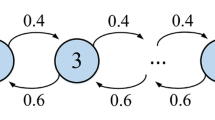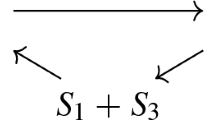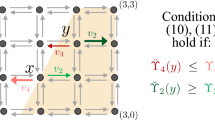Abstract
It is common that probability theory and stochastic process, especially Markov chains, have long been used to study and explain the behaviors of chemical reaction networks (CRNs). Nonetheless, this paper sees things from a reverse angle, devoting itself in synthesizing common probability theory and stochastic process with CRNs. The main motivation is to imitate and explore the evolution of large-scale and complex practical systems based on CRNs, by making use of the inherent parallelism and randomness. In our conference paper, a preliminary but concise approach has been put forward to synthesize the stand-alone examples such as law of total probability, Bayes’ theorem, and n-step transition of Markov chains. To make this methodology systematic and theoretically sound, we enrich and offer more solid foundation for the previous version. Rigorous stability analysis based on ordinary differential equations (ODEs) are provided. This paper further deeply discusses and distinguishes building stochastic models for CRNs and utilizing CRNs to solve stochastic problems. A joint distribution of Markov chains are implemented using molecular reactions as a showcase. In order to enhance the clearness of the results, all the simulations are done according to deterministic mass action. It is worth noting that an already mathematically proven conclusion, which states that nearly an arbitrary set of bimolecular or unimolecular reactions can be implemented by DNA strand displacement reactions, ensures the meaningfulness of our work. It is also believed that, though in its infancy, the proposed approach is also valid for other molecular synthesis than DNA, as long as the kinetics constraints are met.









Similar content being viewed by others
References
Bennett, C.H. (1982). The thermodynamics of computation review. International Journal of Theoretical Physics, 21(12), 905–940.
Berry, G., & Boudol, G. (1992). The chemical abstract machine. Theoretical Computer Science, 96(1), 217–248.
Rothemund, P.W.K. (1995). A DNA and restriction enzyme implementation of turing machines. DNA Based Computers, 27, 75–119.
Pȧun, G., & Rozenberg, G. (2002). A guide to membrane computing. Theoretical Computer Science, 287(1), 73–100.
Lund, K., Manzo, A.J., Dabby, N., Michelotti, N., Johnson-Buck, A., Nangreave, J., Taylor, S., Pei, R., Stojanovic, M.N., Walter, N.G., et al. (2010). Molecular robots guided by prescriptive landscapes. Nature, 465(7295), 206–210.
Stojanovic, M.N., & Stefanovic, D. (2003). A deoxyribozyme-based molecular automaton. Nature Biotechnology, 21(9), 1069–1074.
Sprinzak, D., & Elowitz, M.B. (2005). Reconstruction of genetic circuits. Nature, 438(7067), 443–448.
Seelig, G., Soloveichik, D., Zhang, D.Y., Winfree, E. (2006). Enzyme-free nucleic acid logic circuits. Science, 314(5805), 1585–1588.
Macdonald, J., Li, Y., Sutovic, M., Lederman, H., Pendri, K., Lu, W., Andrews, B.L., Stefanovic, D., Stojanovic, M.N. (2006). Medium scale integration of molecular logic gates in an automaton. Nano Letters, 6(11), 2598–2603.
Soloveichik, D., Seelig, G., Winfree, E. (2010). DNA as a universal substrate for chemical kinetics. Proceedings of the National Academy of Sciences (PNAS), 107(12), 5393–5398.
Adleman, L.M. (1994). Molecular computation of solutions to combinatorial problems. Science, 266(5187), 1021.
Ouyang, Q., Kaplan, P.D., Liu, S., Libchaber, A. (1997). DNA solution of the maximal clique problem. Science, 278(5337), 446–449.
Salehi, S.A., Riedel, M.D., Parhi, K.K. (2015). Markov chain computations using molecular reactions . In Proceedings of IEEE International Conference on Digital Signal Processing (DSP) (pp. 689–693).
Shen, Z., Zhang, C., Ge, L., Zhuang, Y., Yuan, B., You, X. (2016). Synthesis of probability theory based on molecular computation. In Proceedings of IEEE International Workshop on Signal Processing Systems (SiPS) (pp. 27–32).
Chen, H.-L., Doty, D., Soloveichik, D. (2014). Deterministic function computation with chemical reaction networks. Natural Computing, 13(4), 517–534.
Jiang, H., Riedel, M.D., Parhi, K.K. (2013). Digital logic with molecular reactions. In Proceedings of IEEE/ACM International Conference on Computer-Aided Design (ICCAD) (pp. 721–727).
Jiang, H., Riedel, M., Parhi, K. (2011). Synchronous sequential computation with molecular reactions. In Proceedings of the Design Automation Conference (pp. 836–841).
Kharam, A.P., Jiang, H., Riedel, M.D., Parhi, K. (2011). Binary counting with chemical reactions. In Proceedings of Pacific Symposium on Biocomputing (pp. 302–313).
Zhang, C., Ge, L., Zhong, Z., You, X. (2015). Karnaugh map-aided combinational logic design approach with bistable molecular reactions. In Proceedings of IEEE International Conference on Digital Signal Processing (DSP) (pp. 1288–1292).
Ge, L., Zhang, C., Zhong, Z., You, X. (2015). A formal design methodology for synthesizing a clock signal with an arbitrary duty cycle of M/N. In Proceedings of IEEE Workshop on Signal Processing Systems (SiPS) (pp. 1–6).
Ge, L., Zhong, Z., Wen, D., You, X., Zhang, C. (2017). A formal combinational logic synthesis with chemical reaction networks. IEEE Transactions on Molecular Biological and Multi-Scale Communications, 3(1), 33–47.
Wen, D., Ge, L., Lu, Y., Zhang, C., You, X. (2017). A DNA strand displacement reaction implementation-friendly clock design. In Proceedings of IEEE International Conference on Communications (ICC) (pp. 1–6).
Salehi, S.A., Riedel, M.D., Parhi, K.K. (2014). Asynchronous discrete-time signal processing with molecular reactions. In Proceedings of IEEE Asilomar Conference on Signals Systems and Computers (pp. 1767–1772).
Jiang, H., Salehi, S.A., Riedel, M.D., Parhi, K.K. (2013). Discrete-time signal processing with DNA. ACS Synthetic Biology, 2(5), 245–254.
Salehi, S.A., Jiang, H., Riedel, M.D., Parhi, K.K. (2015). Molecular sensing and computing systems, IEEE Transactions on Molecular. Biological and Multi-Scale Communications, 1(3), 249–264.
Salehi, S.A., Parhi, K.K., Riedel, M.D. (2016). Chemical reaction networks for computing polynomials. ACS Synthetic Biology, 6(1), 76–83.
McQuarrie, D.A. (1967). Stochastic approach to chemical kinetics. Journal of Applied Probability, 4(03), 413–478.
van Kampen, N.G. (1995). Stochastic Processes in Physics and Chemistry. Amsterdam: Elsevier.
Anderson, D.F., & Kurtz, T.G. (2011). Continuous Time Markov Chain Models for Chemical Reaction Networks, (pp. 3–42). New York: Springer.
Kannan, K.S., Vallinayagam, V., Venkatesan, P. (2007). Markov chain monte carlo methods in molecular computing. IJISE.
Cardona, M., Colomer, M., Conde, J., Miret, J., Miró, J., Zaragoza, A. (2005). Markov chains: Computing limit existence and approximations with DNA. Biosystems, 81(3), 261–266.
Érdi, P., & Tóth, J. (1989). Mathematical models of chemical reactions: Theory and applications of deterministic and stochastic models. Manchester: Manchester University Press.
Horn, F., & Jackson, R. (1972). General mass action kinetics. Archive for rational mechanics and analysis, 47(2), 81–116.
Kurtz, T.G. (1972). The relationship between stochastic and deterministic models for chemical reactions. The Journal of Chemical Physics, 57(7), 2976–2978.
Howard, P. (2009). Analysis of ode models.
Strogatz, S.H. (2014). Nonlinear dynamics and chaos: with applications to physics, biology, chemistry, and engineering. Boulder: Westview Press.
Wikipedia. [Online]. Available: https://en.wikipedia.org/wiki/Law_of_total_probability.
DeGroot, M.H., & Schervish, M.J. (2012). Probability and Statistics. Boston: Addison-Wesley.
Pachet, F., Roy, P., Barbieri, G., Paris, S.C. (2001). Finite-length markov processes with constraints. Transition, 6(1/3).
Acknowledgements
The authors thank Dr. Xiaoqing Chen for her consistent support to our project. This work is partially supported by NSFC under grants 61501116 and 61571105, Jiangsu Provincial NSF under grant BK20140636, State Key Laboratory of ASIC & System under grant 2016KF007, Student Research Training Program of SEU, Huawei HIRP Flagship under grant YB201504, Intel Collaborative Research Institute for MNC, the Fundamental Research Funds for the Central Universities, and the Project Sponsored by the SRF for the Returned Overseas Chinese Scholars of State Education Ministry.
Author information
Authors and Affiliations
Corresponding author
Rights and permissions
About this article
Cite this article
Shen, Z., Ge, L., Wei, W. et al. Molecular Synthesis for Probability Theory and Stochastic Process. J Sign Process Syst 90, 1479–1494 (2018). https://doi.org/10.1007/s11265-017-1318-7
Received:
Revised:
Accepted:
Published:
Issue Date:
DOI: https://doi.org/10.1007/s11265-017-1318-7




